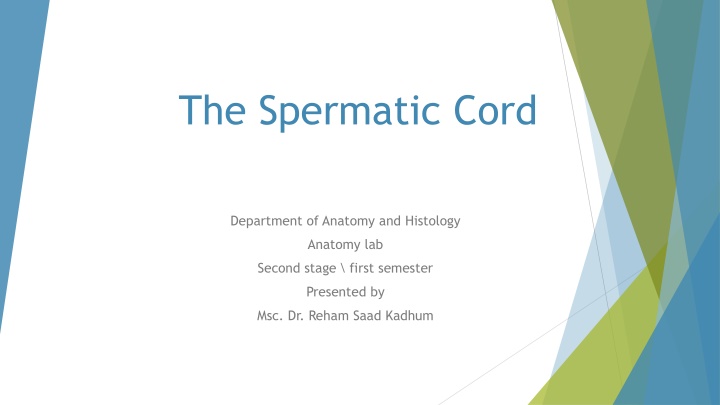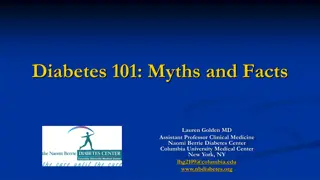Implementing a Registry for Co-Occurring Diabetes and Mental Illness
This presentation discusses the implementation of a registry to enhance adherence to diabetes standards of care among individuals with co-occurring diabetes and mental illness. It highlights population management strategies, benefits of utilizing registries, and key barriers to consider. The initiative aims to improve care coordination, link clients to necessary specialty services, educate about diabetes, and monitor health outcomes effectively over time.
Download Presentation

Please find below an Image/Link to download the presentation.
The content on the website is provided AS IS for your information and personal use only. It may not be sold, licensed, or shared on other websites without obtaining consent from the author.If you encounter any issues during the download, it is possible that the publisher has removed the file from their server.
You are allowed to download the files provided on this website for personal or commercial use, subject to the condition that they are used lawfully. All files are the property of their respective owners.
The content on the website is provided AS IS for your information and personal use only. It may not be sold, licensed, or shared on other websites without obtaining consent from the author.
E N D
Presentation Transcript
The Spermatic Cord Department of Anatomy and Histology Anatomy lab Second stage \ first semester Presented by Msc. Dr. Reham Saad Kadhum
Spermatic cord The spermatic cord is a collection of structures that pass through the inguinal canal to and from the testis It begins at the deep inguinal ring lateral to the inferior epigastric artery and ends at the lower end testis. The structures are as follows: Vas deferens and its arterial supply Testicular artery Testicular veins (pampiniform plexus) Testicular lymph vessels Autonomic nerves Remains of the processus vaginalis Genital branch of the genitofemoral nerve, which supplies the cremaster muscle, and its arterial supply
Vas deference , testicular artery and vein Vas Deferens (Ductus Deferens) The vas deferens is a cordlike structure . It is a thick-walled muscular duct that transports spermatozoa from the epididymis to the urethra. Testicular Artery A branch of the abdominal aorta (at the level of the 2ndlumbar vertebra), It traverses the inguinal canal and supplies the testis and the epididymis Testicular Veins An extensive venous plexus, the pampiniform plexus, leaves the posterior border of the testis As the plexus ascends, it becomes reduced in size so that at about the level of the deep inguinal ring, a single testicular vein is formed. This runs up on the posterior abdominal wall and drains into the left renal vein on the left side and into the inferior vena cava on the right side.
Lymph v, autonomic Ns. supply , genital branch of G.F.N, Lymph Vessels The testicular lymph vessels ascend through the inguinal canal and pass up over the posterior abdominal wall to reach the lumbar (para-aortic) lymph nodes on the side of the aorta at the level of the 1st lumbar vertebra Autonomic Nerves Sympathetic fibers run with the testicular artery from the renal or aortic sympathetic plexuses. Afferent sensory nerves accompany the efferent sympathetic fibers. Processus Vaginalis The remains of the processus vaginalis are present within the cord Genital Branch of the Genitofemoral Nerve This nerve supplies the cremaster muscle .
Covering of Spermatic Cord The coverings of the spermatic cord are three concentric layers of fascia derived from the layers of the anterior abdominal wall 1. External spermatic fascia derived from the external oblique aponeurosis and attached to the margins of the superficial inguinal ring . 2. Cremasteric fascia \ derived from the internal oblique muscle 3. Internal spermatic fascia \derived from the fascia transversalis and attached to the margins of the deep inguinal ring
Scrotum, Testis, and Epididymides Scrotum The scrotum is an outpouching of the lower part of the anterior abdominal wall. It contains the testes, the epididymides, and the lower ends of the spermatic cords . The wall of the scrotum has the following layers : 1. Skin. (thin, wrinkled, and pigmented and forms a single pouch. A slightly raised ridge in the midline indicates the line of fusion of the two lateral labioscrotal swellings. (In the female, the swellings remain separate and form the labia majora.) 2.dartos muscle = fatty layer of superfascial fascia of abdomen 3. Colles fascia = membranous layer of = = = ============== 4. Spermatic fasciae. These three layers lie beneath the superficial fascia and are derived from the three layers of the anterior abdominal wall on each side, as previously explained. 5. covering of testis ( tuniqa vaginalis = 2 layers parietal and visceral ; tunica albugina )
The function of the cremaster muscle is to raise the testis and the scrotum upward for warmth and for protection against injury. For testicular temperature and fertility, Lymph Drainage of the Scrotum Lymph from the skin and fascia, including the tunica vaginalis, drains into the superficial inguinal lymph nodes Testis The testis is a firm, mobile organ lying within the scrotum. The left testis usually lies at a lower level than the right. Each testis is surrounded by a tough fibrous capsule, the tunica albuginea. Extending from the inner surface of the capsule is a series of fibrous septa that divide the interior of the organ into lobules. Lying within each lobule are one to three coiled seminiferous tubules. The tubules open into a network of channels called the rete testis. Small efferent ductules connect the rete testis to the upper end of the epididymis .
Epididymis The epididymis is a firm structure lying posterior to the testis, with the vas deferens lying on its medial side . It has an expanded upper end, the head, a body, and a pointed tail inferiorly. Laterally, a distinct groove lies between the testis and the epididymis, which is lined with the inner visceral layer of the tunica vaginalis and is called the sinus of the epididymis The tube emerges from the tail of the epididymis as the vas deferens, which enters the spermatic cord
Blood Supply of the Testis and Epididymis The testicular artery is a branch of the abdominal aorta. The testicular veins emerge from the testis and the epididymis as a venous network, the pampiniform plexus. This becomes reduced to a single vein as it ascends through the inguinal canal. Note \ The right testicular vein drains into the inferior vena cava, and the left vein joins the left renal vein.
Lymph Drainage of the Testis and Epididymis The lymph vessels ascend in the spermatic cord and end in the lymph nodes on the side of the aorta (lumbar or para-aortic) nodes at the level of the 1stLumbar vertebra (i.e., on the transpyloric plane). This is to be expected because during development the testis has migrated from high up on the posterior abdominal wall, down through the inguinal canal, and into the scrotum, dragging its blood supply and lymph vessels after it.























